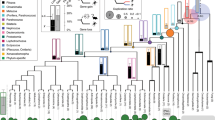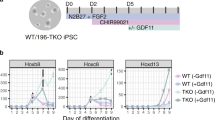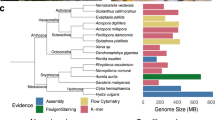Abstract
ORGANIZATION into gene clusters is an essential and diagnostic feature of Hox genes1. Insect and nematode genomes possess single Hox gene clusters (split in Drosophila); in mammals, there are 38 Hox genes in four clusters on different chromosomes2,3. A collinear relationship between chromosomal position, activation time and anterior expression limit of vertebrate Hox genes suggests that clustering may be important for precise spatiotemporal gene regulation and hence embryonic patterning2,4. Hox genes have a wide phylogenetic distribution within the metazoa, and are implicated in the control of regionalization along the anteroposterior body axis2,5. It has been suggested that changes in Hox gene number and genomic organization played a role in metazoan body-plan evolution6–8, but identifying significant changes is difficult because Hox gene organization is known from only very few and widely divergent taxa (principally insects, nematodes and vertebrates)3. Here we analyse the complexity and organization of Hox genes in a cephalochordate, amphioxus, the taxon thought to be the sister group of the vertebrates9. We find that the amphioxus genome has only one Hox gene cluster. It has similar genomic organization to the four mammalian Hox clusters, and contains homologues of at least the first ten paralogous groups of vertebrate Hox genes in a collinear array. Remarkably, this organization is compatible with that inferred for a direct ancestor of the vertebrates; we conclude that amphioxus is a living representative of a critical intermediate stage in Hox cluster evolution.
This is a preview of subscription content, access via your institution
Access options
Subscribe to this journal
Receive 51 print issues and online access
$199.00 per year
only $3.90 per issue
Buy this article
- Purchase on Springer Link
- Instant access to full article PDF
Prices may be subject to local taxes which are calculated during checkout
Similar content being viewed by others
References
Scott, M. Cell 71, 551–553 (1992).
McGinnis, W. & Krumlauf, R. Cell 68, 283–302 (1992).
Bürglin, T. & Ruvkun, G. Curr. Opin. Gen. Dev. 3, 615–620 (1993).
Izpisúa-Beimonte, J.-C. et al. EMBO J. 10, 2279–2289 (1991).
Slack, J. M. W., Holland, P. W. H. & Graham, C. F. Nature 361, 490–492 (1993).
Akam, M. et al. Development 104, suppl., 123–133 (1988).
Kappen, C., Schughart, K. & Ruddle, F. H. Proc. natn. Acad. Sci. U.S.A. 86, 5459–5463 (1989).
Holland, P. W. H. BioEssays 14, 267–273 (1992).
Willey, A. Amphioxus and the Ancestry of the Vertebrates (Macmillan, New York, 1894).
Kappen, C. & Ruddle, F. H. Curr. Opin. Gen. Dev. 3, 931–938 (1993).
Schubert, F. R., Nieselt-Struwe, K. & Gruss, P. Proc. natn. Acad. Sci. U.S.A. 90, 143–147 (1993).
Holland, P. W. H., Garcia-Fernàndez, J., Holland, L. Z., Williams, N. A. & Holland, N. D. J. Mar. Biol. Assoc. 74, 49–60 (1994).
Holland, P. W. H., Holland, L. Z., Williams, N. A. & Holland, N. D. Development 116, 653–661 (1992).
Izpisúa-Belmonte, J.-C. et al. Nature 350, 585–589 (1991).
Acampora, D. et al. Nucleic Acids Res. 17, 10385–10402 (1989).
Rubock, M. J. et al. Proc. natn. Acad. Sci. U.S.A. 87, 4751–4755 (1990).
Pendleton, J. W., Nagai, B. K., Murtha, M. T. & Ruddle, F. H. Proc. natn. Acad. Sci. U.S.A. 90, 6300–6304 (1993).
Dekker, E.-J. et al. Mech. Dev. 40, 3–12 (1992).
Belleville, S. et al. Gene 114, 179–186 (1992).
Molven, A., Hordvik, I. & Njolstad, P. R. Biochim. biophys. Acta 1173, 102–106 (1993).
Sansom, I. J., Smith, M. P., Armstrong, H. A. & Smith, M. M. Science 256, 1308–1311 (1992).
Tabin, C. J. Development 116, 289–196 (1992).
Lundin, L. Genomics 16, 1–19 (1993).
Bürglin, T. in A Guidebook for Homeobox Genes (ed. Duboule, D.) 25–71 (Oxford University Press, Oxford, 1994).
Kappen, C., Schughart, K. & Ruddle, F. H. Genomics 18, 54–70 (1993).
Schughart, K., Utset, M. F., Awgulewitsch, A. & Ruddle, F. H. Proc. natn. Acad. Sci. U.S.A. 85, 5582–5586 (1988).
Holland, P. W. H. in Essential Developmental Biology: A Practical Approach (eds Stern, C. D. & Holland, P. W. H.) 243–255 (Oxford University Press, Oxford, 1993).
Webster, P. J. & Mansour, T. E. Mech. Dev. 38, 25–32 (1992).
Bürglin, T. R., Finney, M., Coulson, A. & Ruvkun, G. Nature 341, 239–243 (1989).
Author information
Authors and Affiliations
Rights and permissions
About this article
Cite this article
Garcia-Fernàndez, J., Holland, P. Archetypal organization of the amphioxus Hox gene cluster. Nature 370, 563–566 (1994). https://doi.org/10.1038/370563a0
Received:
Accepted:
Issue Date:
DOI: https://doi.org/10.1038/370563a0
This article is cited by
-
Sequential and directional insulation by conserved CTCF sites underlies the Hox timer in stembryos
Nature Genetics (2023)
-
Evolution and genomic organization of the insect sHSP gene cluster and coordinate regulation in phenotypic plasticity
BMC Ecology and Evolution (2021)
-
Deeply conserved synteny resolves early events in vertebrate evolution
Nature Ecology & Evolution (2020)
-
A Hox-TALE regulatory circuit for neural crest patterning is conserved across vertebrates
Nature Communications (2019)
-
In vivo Hox binding specificity revealed by systematic changes to a single cis regulatory module
Nature Communications (2019)
Comments
By submitting a comment you agree to abide by our Terms and Community Guidelines. If you find something abusive or that does not comply with our terms or guidelines please flag it as inappropriate.



